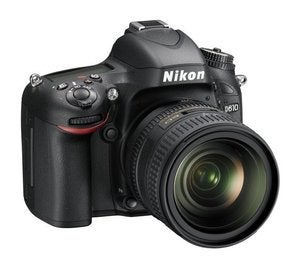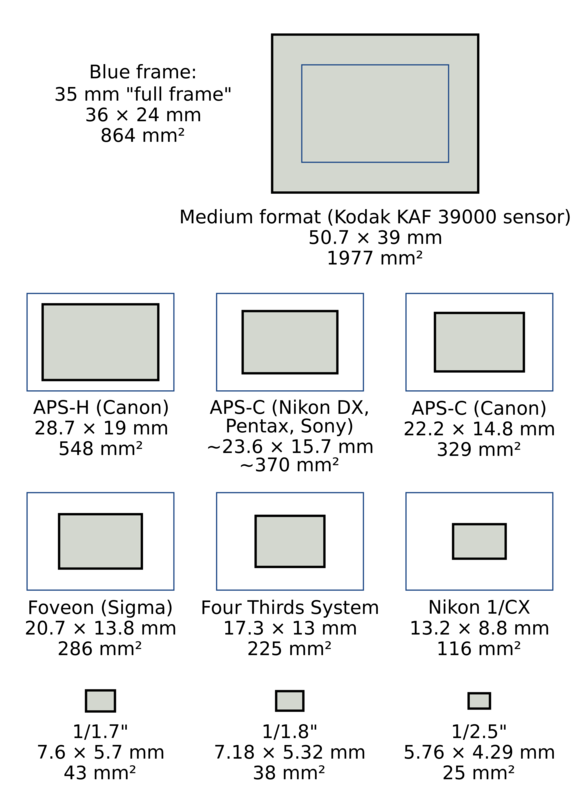What Is The Sensor On A Camera
The soul of a digital camera is its sensor—to determine image size, resolution, low-light functioning, depth of field, dynamic range, lenses, and even the photographic camera's physical size, the sensor is primal.
An image sensor is a solid-country device, the part of the photographic camera'due south hardware that captures light and converts what yous see through a viewfinder or LCD monitor into an paradigm. Think of the sensor as the electronic equivalent of flick. With picture cameras, you lot could choose from hundreds of flick brands, each with its own unique and identifiable characteristics. With digital cameras, much of that technology is congenital into the hardware, and you can apply special filmlike effects later with software.
Your photographic camera's sensor determines how good your images expect and how large yous tin can scale them or print them. Epitome quality depends non just on the size of the sensor, simply also on how many millions of pixels (light-sensitive photosites) fit on it, and the size of those pixels.
The sensor size also affects what you see through the viewfinder—the human relationship between what you're shooting and what actually gets recorded in the frame and passed through to the retention card. Smaller sensors apply a crop factor to lenses, capturing less of the scene than full-frame sensors do. The full-frame reference point is always traditional 35mm film.
Confused notwithstanding? Don't be. Even if yous don't know a CCD from a CMOS from a Iv Thirds from an APS-C, this guide breaks downwards that intimidating alphabet soup and walks you lot through the sensors you lot're likely to run across.
 Canon
Canon Sensor types
The most common types of sensors are CCD (charged coupled device) and CMOS (complementary metal–oxide–semiconductor).
CCD is one of the oldest image-capture technologies for digital cameras and has long offered superior image quality compared with CMOS sensors, with better dynamic range and noise control. Although CCD is even so prevalent in budget compact models, its bones construction and greater power consumption have for the large part prompted camera manufacturers to replace it with CMOS alternatives.
CMOS has been considered an inferior competitor to CCD, but today's CMOS sensors have been upgraded to match and fifty-fifty transcend the CCD standard. With more born functionality than CCDs, CMOS sensors piece of work more efficiently, require less ability, and perform better for high-speed burst modes.
The newer Foveon X3 sensor, based on CMOS technology, is used only in Sigma's meaty cameras and DSLRs. Live MOS is a brand name for image sensors that Leica, Olympus, and Panasonic use in the Four Thirds Organisation DSLRs that they've been manufacturing since 2006. These sensors reportedly offer CCD paradigm quality with the lower power consumption of a CMOS.
Sensor sizes

Full frame (36mm by 24mm): The largest sensor size is called full frame, as it is the same equally a frame of 35mm moving picture. Total-frame sensors are almost twice equally big equally APS-C sensors. Hefty pro-level beasts such as the Nikon D800, the Canon EOS 5D Mark III, and the Nikon D4 have full-frame sensors. However, over the past year, smaller fixed-lens cameras such as the Sony Cyber-shot RX1 have also featured full-frame sensors. The Sony Alpha SLT-A99, a DSLR-like photographic camera that has a fixed translucent mirror equally opposed to one that flips dorsum to capture a shot, is too a total-frame model.
With full-frame sensors, you have no crop factor, and then what you lot meet through the viewfinder is what you shoot. Larger sensors in full-frame models, when paired with wide discontinuity lenses, can deliver extremely shallow depth of field—not bad for macro and video piece of work. Generally, the larger the sensor, the bigger the camera body and the larger the lenses necessary to take reward of it, though that is starting to change.
APS-H (28.7mm by 19mm): APS (active pixel sensor) is the most popular sensor type for both interchangeable-lens and higher-quality fixed-lens cameras, and information technology is present in a vast portion of consumer and prosumer DSLRs. The APS-H type combines a comparatively big sensor with a moderate pixel count to boost speed and ISO operation. It applies a 1.3x crop cistron to mounted lenses. The Catechism 1D Marking IV and Canon 1D Mark III have this kind of sensor.

APS-C (23.6mm by 15.8mm): Virtually major-brand prosumer and enthusiast DSLRs from Canon, Nikon, Pentax, and Sony use an APS-C sensor—only not all APS-C sensors are equal. A Catechism APS-C sensor measures 22.2mm by 14.8mm while the Sony, Pentax, Fujifilm, and Nikon (DX) versions range from 23.5mm by 15.6mm to 23.7mm by 15.6mm. The Ricoh GR (23.7mm by fifteen.7mm), the Canon EOS M (22.3mm by fourteen.9mm), the Sony NEX line, and Fujifilm cameras all utilize APS-C sensors.
Four Thirds (17.3mm by 13mm): Roughly a quarter of the size of a full-frame sensor, Iv Thirds is an open DSLR standard created past Olympus and Kodak and is used in all Olympus and Panasonic Four Thirds and Micro Four Thirds DSLRs. It has a 2x crop cistron, which doubles the effective focal length of a mounted lens. The new Olympus OM-D E-M1, the Olympus Pen Eastward-PL5, and the Panasonic Lumix GH1 utilise this sensor.
CX format (1 inch): Announced in 2011, Nikon's CX format has been adopted on the Nikon 1 camera system. And in 2012, Sony released the pocket-sized Cyber-shot DSC-RX100 digital photographic camera, which uses a i-inch (13.2mm by 8mm) sensor with a two.7x crop factor.
 Wikimedia Commons
Wikimedia Commons Camera sensor sizes and crop factors.
Pocket-sized sensors
The concluding two sizes listed below make no practical sense. Equally a betoken of reference, these small-scale-sensor definitions are derived from the size of video camera tubes used in CRT TVs circa the 1950s.
1/1.7 inch (vii.6mm past v.7mm): Amidst the largest sensor sizes used in compact cameras, these sensors let larger pixels for improved noise operation over standard pocket indicate-and-shoots. Larger pixels more ably handle gaps in brightness to reproduce meliorate prototype item.
i/2.5 inch (5.76mm by 4.29mm): This size is among the smallest sensors, typically used in low-priced signal-and-shoot models. While such tiny sensors are cheaper to industry, their smaller pixels crank up image noise and reduce dynamic range, resulting in less-than-elevation images. Nevertheless, the results all the same may be better than those from a smartphone camera, especially for portraits of people.
Among other variations in this category are one/3.2, 1/ii.iii, ii/3, 1/iii.two, 1/1.ii, and 1/ane.8. With sensors as tiny as 1/2.seven-inch (5.37mm past iv.04mm), information technology's no mystery that smartphones are making serious inroads on compact-camera sales.
What goes where?
Compact mirrorless interchangeable-lens cameras typically feature a range of sensor sizes. Smaller ones include the 1/2.iii-inch (vi.17mm past 4.55mm) sensor in the Pentax Q, and the i-inch sensor used in the Nikon ane Serial. The Panasonic Lumix GF5, the Olympus Pen series, and the OM-D E-M5 accept Micro Four Thirds 4/3-inch (17.3mm by 13mm) sensors.
Advanced meaty cameras with fixed lenses, such as the Fuji X100S (23.6mm by fifteen.8mm) and Nikon Coolpix A (23.6mm past xv.7mm), feature an APS-C sensor. The Fujifilm X20 has a 2/three-inch (viii.8mm by 6.6mm) sensor while the Canon G1 X has a 1.5-inch sensor (18.7mm by 14mm).
Standard point-and-shoot cameras such as the Canon PowerShot SX280 HS and the Samsung Galaxy Camera use 1/two.three-inch sensors (6.17mm past 4.55 mm), while ameliorate ones such every bit the Nikon P7700 have a larger 1/1.7-inch (seven.44mm by 5.58 mm) sensor.
Smartphones such as the iPhone 5s and the HTC One have a 1/iii-inch paradigm sensor (4.8mm by 3.6mm) and fewer pixels. The Nokia Lumia 1020 boasts a one/one.five-inch, 41-megapixel CMOS sensor. The Sony Xperia Z1 carries a i/2.3-inch, 20.7-megapixel sensor. The Samsung Galaxy S4 Zoom features a sixteen-megapixel, 1/2.3-inch sensor.

Packing megapixels
You may take heard of the "megapixel myth," which states that the more than megapixels your camera can pile on its sensor, the meliorate your images volition exist. This is not true. Yous don't just want more than pixels, merely rather the correct number of pixels relative to the size of the sensor. And the right number depends on what yous intend to exercise with your photos. For massive cropping or actress-large printing, additional resolution is useful. For online sharing or conventional press, resolution is less important. Trade-offs include large file sizes and the demand for more processing power to handle loftier-res photos, versus noise in lower-resolution images.
Smaller sensors that cram pixels together tend to take poorer low-light performance and produce noisy artifacts.
What to look for
Whenever possible, as y'all shop for a new camera, pay attention to what kind of sensor it uses. Because the sensor size and type influence such a significant portion of your camera's output, the sensor is a critical factor in size, resolution, functioning, and price.
Image sources: Canon, Wikimedia Eatables
Source: https://www.techhive.com/article/602116/demystifying-digital-camera-sensors-once-and-for-all.html
Posted by: crumpmathereard1954.blogspot.com

0 Response to "What Is The Sensor On A Camera"
Post a Comment